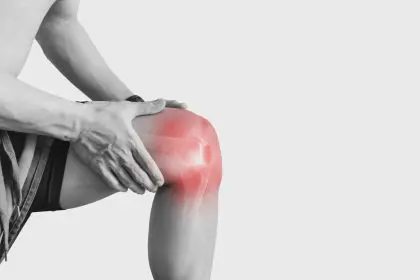A debilitating autoimmune condition silently attacks the spine and surrounding joints, causing inflammation that gradually transforms flexible vertebrae into rigid, fused bone. Ankylosing spondylitis affects approximately 2.7 million Americans, yet many sufferers endure years of misdiagnosis while their spine slowly loses mobility and function.
This chronic inflammatory disease primarily targets the sacroiliac joints where the spine connects to the pelvis, before spreading upward through the vertebral column. The condition creates a cascade of symptoms that extend far beyond back pain, affecting multiple body systems and dramatically altering quality of life for those diagnosed.
Understanding the complex interplay of genetic predisposition, environmental triggers, and immune system dysfunction helps explain why this condition develops and how it progresses through distinct stages of spinal deterioration.
Early warning signs appear in young adults
Ankylosing spondylitis typically manifests during the prime years of life, with most diagnoses occurring between ages 17 and 35. The initial symptoms often develop so gradually that many people dismiss them as routine back strain or exercise-related soreness, delaying proper medical evaluation for months or years.
The hallmark early symptom involves persistent lower back pain and stiffness that worsens during periods of inactivity, particularly after sleeping or sitting for extended periods. This morning stiffness can last for hours, requiring significant movement and stretching before any relief occurs. Unlike mechanical back pain that improves with rest, inflammatory back pain associated with ankylosing spondylitis actually worsens during periods of immobility.
Pain typically centers around the sacroiliac joints, creating deep aching sensations in the lower back and buttocks that may alternate from side to side. Many people describe this discomfort as a dull, persistent ache that seems to emanate from deep within the pelvis, often radiating down into the thighs or up into the lower ribs.
The pain pattern follows predictable cycles, with symptoms typically worse in the early morning hours and during the second half of the night. This timing occurs because inflammatory chemicals accumulate during periods of rest, creating increased joint stiffness and discomfort that gradually improves with movement and activity throughout the day.
Progressive spine fusion creates lasting disability
As ankylosing spondylitis advances, inflammation triggers the formation of new bone tissue between vertebrae, gradually fusing individual spinal segments into solid, immobile units. This process, called ankylosis, can eventually create a completely rigid spine that resembles bamboo on X-ray images.
The fusion process typically begins at the sacroiliac joints and progresses upward through the lumbar, thoracic, and cervical spine regions. Early fusion may actually reduce pain levels as inflamed joints become immobilized, but this temporary relief comes at the cost of permanent mobility loss.
Spinal fusion severely limits the ability to bend, twist, or rotate the torso, making simple activities like looking over the shoulder while driving or picking up objects from the floor increasingly difficult or impossible. Advanced cases may result in a forward-curved posture that cannot be corrected, significantly impacting balance and breathing capacity.
The rib cage can also become affected, with inflammation attacking the joints where ribs connect to the spine and sternum. This involvement restricts chest expansion during breathing, potentially leading to reduced lung capacity and increased susceptibility to respiratory infections.
Peripheral joints suffer widespread inflammation
While ankylosing spondylitis primarily affects the spine, the condition frequently involves peripheral joints throughout the body. The hips bear particular vulnerability, with inflammation and eventual joint damage occurring in approximately 50% of patients within the first 10 years of disease onset.
Hip involvement creates significant functional limitations, as these joints play crucial roles in walking, climbing stairs, and transitioning between sitting and standing positions. The combination of spinal fusion and hip joint damage can severely compromise mobility and independence.
Shoulder joints may develop inflammation and stiffness that limits overhead reaching and arm movement. This involvement particularly affects activities requiring lifting, carrying, or manipulating objects above chest level.
The knees and ankles can also become inflamed, though this typically occurs less frequently than hip and shoulder involvement. When present, knee inflammation causes swelling, pain, and stiffness that affects weight-bearing activities and walking.
Small joints in the hands and feet may occasionally develop inflammation, though this occurs less commonly than in other forms of inflammatory arthritis. When present, these symptoms can affect fine motor skills and daily activities requiring precise hand movements.
Eye inflammation creates serious complications
Approximately 40% of people with ankylosing spondylitis develop acute anterior uveitis, a painful inflammation of the eye’s middle layer that requires immediate medical attention. This complication can occur at any stage of the disease and may even precede the development of spinal symptoms.
Acute uveitis typically affects one eye at a time, causing severe pain, light sensitivity, blurred vision, and excessive tearing. The affected eye often appears red and inflamed, with symptoms developing rapidly over hours or days rather than gradually like spinal manifestations.
Without prompt treatment, uveitis can cause permanent vision damage including cataracts, glaucoma, or retinal complications. The condition tends to recur in episodes, requiring ongoing monitoring and rapid intervention when symptoms develop.
The connection between ankylosing spondylitis and uveitis stems from shared genetic factors and immune system pathways that affect both joint tissue and eye structures. This association highlights the systemic nature of the disease beyond its primary spinal manifestations.
Cardiovascular complications threaten heart health
Chronic inflammation associated with ankylosing spondylitis significantly increases the risk of cardiovascular disease, with patients facing elevated rates of heart attack, stroke, and heart rhythm abnormalities. The inflammatory process affects blood vessels throughout the body, accelerating atherosclerosis and increasing blood pressure.
Aortic regurgitation, a condition where the heart’s main valve fails to close properly, occurs more frequently in people with ankylosing spondylitis. This complication can develop silently over years, gradually reducing heart efficiency and potentially leading to heart failure if left untreated.
The inflammation can also affect the electrical conduction system of the heart, causing irregular heart rhythms that may require medication or device intervention. These cardiac complications often develop without obvious symptoms, making regular cardiovascular monitoring essential for early detection and treatment.
Genetic factors determine disease susceptibility
The strongest risk factor for developing ankylosing spondylitis involves carrying the HLA-B27 gene variant, found in approximately 90% of people with the condition. However, only 5% of people who carry this gene actually develop the disease, indicating that additional factors must trigger its onset.
The HLA-B27 protein plays a crucial role in immune system function, helping T-cells recognize foreign substances that require immune responses. Variations in this protein may cause the immune system to mistakenly attack healthy joint tissue, initiating the inflammatory cascade that characterizes ankylosing spondylitis.
Family clustering provides strong evidence for genetic influence, with relatives of affected individuals facing 10 to 20 times higher risk of developing the condition compared to the general population. Multiple genes likely contribute to disease susceptibility, though HLA-B27 remains the most significant genetic marker.
Different ethnic populations show varying rates of HLA-B27 carriage and ankylosing spondylitis prevalence. Some Native American tribes carry the gene variant in up to 50% of individuals, while it occurs in less than 1% of people from certain African and Asian populations.
Environmental triggers activate immune dysfunction
While genetic predisposition provides the foundation for ankylosing spondylitis development, environmental factors likely serve as triggers that activate the disease process in susceptible individuals. Bacterial infections, particularly involving the digestive tract, may initiate immune responses that cross-react with joint tissue.
Certain bacterial species contain proteins that closely resemble human joint proteins, potentially causing molecular mimicry where immune responses against infectious agents inadvertently target healthy tissue. This mechanism may explain why some people develop ankylosing spondylitis following episodes of gastroenteritis or other bacterial infections.
Stress, both physical and emotional, may influence disease onset and progression by affecting immune system function and inflammatory responses. Chronic stress can dysregulate immune function and increase susceptibility to autoimmune disease development.
Smoking appears to worsen ankylosing spondylitis symptoms and accelerate spinal fusion, though it’s unclear whether tobacco use contributes to initial disease development. The inflammatory effects of smoking may amplify existing disease processes and reduce treatment effectiveness.
Hormonal influences affect disease patterns
The significant male predominance in ankylosing spondylitis, with men affected 2 to 3 times more frequently than women, suggests important hormonal influences on disease development and progression. Testosterone and other male hormones may influence immune system function in ways that increase susceptibility to this particular autoimmune condition.
Women with ankylosing spondylitis often experience different symptom patterns, with more peripheral joint involvement and less severe spinal fusion compared to men. These differences may reflect hormonal influences on inflammation and bone formation processes.
Pregnancy can significantly impact disease activity, with many women experiencing symptom improvement during pregnancy followed by potential flares after delivery. These changes likely reflect the complex hormonal and immune system modifications that occur during pregnancy and postpartum periods.
Age and timing influence disease severity
Earlier disease onset, particularly during the teenage years, often correlates with more severe long-term outcomes including extensive spinal fusion and greater functional disability. This pattern may reflect longer disease duration or greater inflammatory activity during periods of rapid skeletal growth and development.
The timing of diagnosis and treatment initiation significantly impacts long-term outcomes, with early intervention potentially slowing disease progression and preserving spinal mobility. However, the gradual onset and nonspecific early symptoms often delay diagnosis for years after initial symptom development.
Disease activity tends to fluctuate over time, with periods of increased inflammation and symptoms alternating with phases of relative stability. Understanding these patterns helps patients and healthcare providers anticipate symptom changes and adjust treatment approaches accordingly.
The complex interplay of genetic susceptibility, environmental triggers, and immune system dysfunction creates the perfect storm that leads to ankylosing spondylitis development. While researchers continue investigating the precise mechanisms involved, current understanding provides valuable insights for early recognition, accurate diagnosis, and effective treatment of this challenging condition.

















